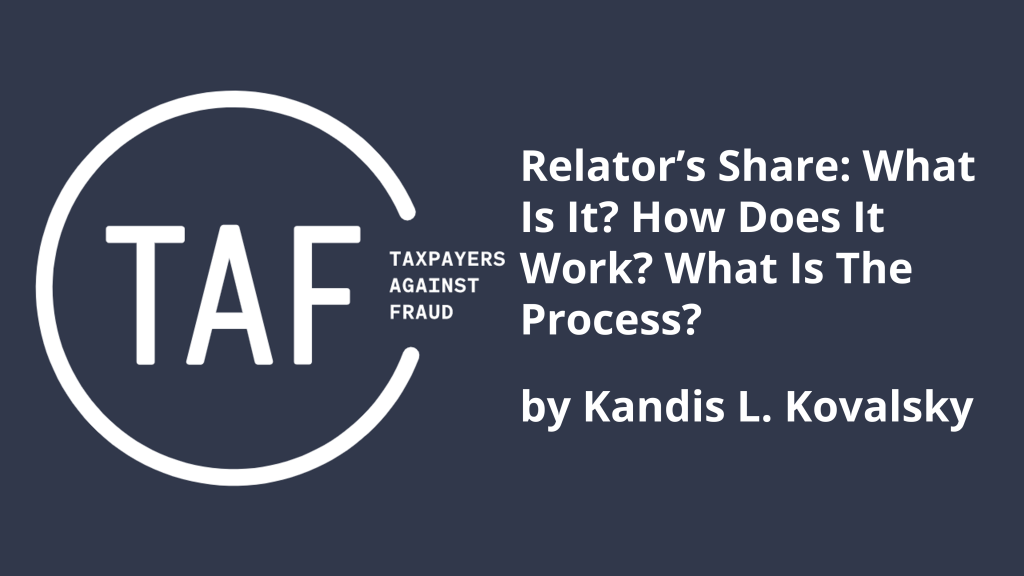 In the October 2022 Edition of Taxpayers Against Fraud (TAF) Newsletter, Kandis Kovalsky wrote “Relator’s Share: What Is It? How Does It Work? What Is The Process?”
In the October 2022 Edition of Taxpayers Against Fraud (TAF) Newsletter, Kandis Kovalsky wrote “Relator’s Share: What Is It? How Does It Work? What Is The Process?”
To incentivize whistleblowers to assist the Government in combatting fraud on the Government and its taxpayers, the False Claims Act, 31 U.S.C. § 3729, et seq. (the “FCA”) ensures that a whistleblower under the FCA (referred to as a “Relator”) receives at least 15 percent of the proceeds recovered by the Government in any action filed under the FCA by a Relator (referred to as a “qui tam” action). A Relator receives 15 percent of the proceeds of an FCA action just by causing a complaint to be filed; 15 percent is the minimum.
A Relator’s share of a qui tam action’s proceeds can range up to thirty percent of the monies recovered. Where exactly a Relator’s share falls on this 15-30% spectrum depends on many factors. The main factor is whether the Government intervenes in the action. When the Government intervenes in a qui tam action, the Government takes over the prosecution of the case.
Even when the Government does not intervene in a qui tam action, a Relator is still entitled to prosecute the case, through their counsel. When the Government intervenes, the Government uses its resources to prosecute the case, whereas when the Government does not intervene, the Relator uses his or her resources to prosecute the case, which explains why the awards to Relators in intervened cases are almost always a lower percentage of the recovery than in non-intervened cases.
When the Government decides to intervene in a qui tam action, an event that occurs in approximately 20% of qui tam actions, the Relator is entitled to receive at least 15% but not more than 25% of the proceeds of the action, as described in 31 U.S.C. § 3730(d)(1). When the Government does not intervene in a qui tam action, the amount paid to the Relator shall not be less than 25% and not more than 30% of the proceeds of the action or settlement, as described in 31 U.S.C. § 3730(d)(2). The reason the Government still receives the bulk of a qui tam action’s proceeds even when it does not intervene is because, despite not intervening, the Government remains the real party in interest, and the party that was harmed.
After a qui tam case concludes, whether by trial or settlement, the Relator and the Government will engage in discussions about, among other things, the Relator’s share of the action’s proceeds. In practice, the Relator’s share of the proceeds often falls between 18% and 22% for intervened cases, and around 27% or 28% for non-intervened cases. This variation in share percentages can be credited to the different factors considered by the Department of Justice (“DOJ”) in connection with qui tam actions. Certain factors increase a Relator’s share percentage, while others decrease it.
In addition to intervention, another factor that can often influence where on the spectrum a Relator’s award falls is the amount of the proceeds. A larger recovery means the Government will receive a larger sum of money, even if the Relator is awarded a percentage of the proceeds that falls on the high-end of the spectrum. Another factor that can influence the size of a Relator’s award is the Relator’s job title and position.
Where a Relator is a high-level executive, the Government may be incentivized to offer a higher reward than where a Relator is a lower-level employee. This is because the Government is incentivized to encourage high-ranking executives to expose fraud, as high-level executives are more likely than lower-level employees to have direct evidence of fraud at a company.
In intervened cases, the timing of when the Government intervenes can influence the amount of the Relator’s award. If the Government intervened in the early stages of the case, it is likely that a Relator will be awarded a lesser percentage than in cases where the Government intervened in the later stages of the case. This is because the amount of work that the Relator and his or her counsel must do in cases with subsequent Government intervention is greater than in cases where the Government intervenes right away.
Other factors that can commonly influence the size of a Relator’s award include whether the information obtained by the Relator was first-hand, when the Relator learned about the fraud, and the extent to which the Relator participated in the fraud. A Relator can rest assured, however, that they are still guaranteed a minimum of fifteen percent of the monies awarded in a successful qui tam action, with the potential to earn up to 30% of the proceeds.
Kandis L. Kovalsky is a member of Kang Haggerty LLC. Her whistleblower practice focuses on healthcare fraud. Kandis represents relators in high stakes qui tam actions filed under the federal and state False Claims Acts relating to fraud on government healthcare payors such as Medicare, Medicaid, Department of Defense TRICARE, State Children’s Health Insurance Program, Veterans Health Administration, and the Indian Health Service program.
 Kang Haggerty News
Kang Haggerty News

